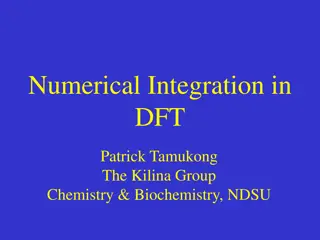NUTS AND BOLTS OF DFT CALCULATIONS
Exploring the fundamental concepts of DFT calculations including reciprocal space, Brillouin zone, k points selection, and computational efficiency. Learn about Bloch's theorem, Monkhorst-Pack method, and the importance of symmetry in reducing computational workload. Dive into the world of DFT with this comprehensive guide.
Download Presentation

Please find below an Image/Link to download the presentation.
The content on the website is provided AS IS for your information and personal use only. It may not be sold, licensed, or shared on other websites without obtaining consent from the author.If you encounter any issues during the download, it is possible that the publisher has removed the file from their server.
You are allowed to download the files provided on this website for personal or commercial use, subject to the condition that they are used lawfully. All files are the property of their respective owners.
The content on the website is provided AS IS for your information and personal use only. It may not be sold, licensed, or shared on other websites without obtaining consent from the author.
E N D
Presentation Transcript
NUTS AND BOLTS OF DFT CALCULATIONS
3.1 RECIPROCAL SPACE AND k POINTS 3.1.1 Plane Waves and the Brillouin Zone If we solve the Schr dinger equation for this periodic system, the solution must satisfy a fundamental property known as Bloch s theorem, which states that the solution can be expressed as a sum of terms with the form: where uk(r) is periodic in space with the same periodicity as the supercell. 2
The space of vectors k is called reciprocal space (or simply k space). We define three vectors that define positions in reciprocal space. These vectors are called the reciprocal lattice vectors, b1, b2, and b3, and are defined so that ai bjis 2 if i=j and 0 otherwise. This choice means that 3
We can define a primitive cell in reciprocal space. Because this cell has many special properties, it is given a name: it is the Brillouin zone (often abbreviated to BZ). 5
3.1.2 Choosing k Points in the Brillouin Zone The solution that is used most widely was developed by Monkhorst and Pack in 1976. Most DFT packages offer the option of choosing k points based on this method. In practice, how should we choose how many k points to use? 6
The last column in Table 3.2 lists the computational time taken for the total energy calculations, normalized by the result for M=1. if M is an odd number, then the amount of time taken for the calculations with either M or (M+1) was close to the same. This occurs because the calculations take full advantage of the many symmetries that exist in a perfect fcc solid. 9
This reduced region in k space is called the irreducible Brillouin zone (IBZ). To show how helpful symmetry is in reducing the work required for a DFT calculation, we have repeated some of the calculations from Table 3.2 for a four-atom supercell in which each atom was given a slight displacement away from its fcc lattice position. 10
3.1.3 MetalsSpecial Cases in k Space One useful definition of a metal is that in a metal the Brillouin zone can be divided into regions that are occupied and unoccupied by electrons. The surface in k space that separates these two regions is called the Fermi surface. 12
We will describe the two best-known methods to solve the problem of slow convergence of metal calculations. The first is called the tetrahedron method. The idea behind this method is to use the discrete set of k points to define a set of tetrahedra that fill reciprocal space and to define the function being integrated at every point in a tetrahedron using interpolation. 13
A different approach to the discontinuous integrals that appear for metals are the smearing methods. The idea of these methods is to force the function being integrated to be continuous discontinuity. by smearing out the 14
An example of a smearing function is the FermiDirac function: Figure 3.3 shows the shape of this function for several values of . 15
3.1.4 Summary of k Space The key ideas related to getting well-converged results in k space include: 1. Before pursuing a large series of DFT calculations for a system of interest, numerical convergence of the calculations with respect to the number of k points should be obtained. 2. The number of k points used in any calculation should be reported since not doing so makes reproduction of the result difficult. data exploring the 17
3. Increasing the volume of a supercell reduces the number of k points needed to achieve convergence because volume increases in real space correspond to volume decreases in reciprocal space. 4. If calculations involving supercells with different volumes are to be compared, choosing k points so that the density of k points in reciprocal space is comparable for the different supercells is a useful way to have comparable levels of convergence in k space. 18
5. Understanding how symmetry is used to reduce the number of k points for which calculations are actually performed can help in understanding how long individual calculations will take. But determined by the density of k points in the full Brillouin zone, not just the number of k points in the irreducible Brillouin zone. 6. Appropriate methods must be used to accurately treat k space for metals. overall convergence is 19
3.2 ENERGY CUTOFFS Our lengthy discussion of k space began with Bloch s theorem, which tells us that solutions of the Schr dinger equation for a supercell have the form where uk(r) is periodic in space with the same periodicity as the supercell. It is now time to look at this part of the problem more carefully. The periodicity of uk(r) means that it can be expanded in terms of a special set of plane waves: 20
Combining the two equations above gives: The interpretation as solutions of the Schr dinger equation: they are solutions with kinetic energy: functions appearing in Eq.(3.13) have a simple 21
As a result, it is usual to truncate the infinite sum above to include only solutions with kinetic energies less than some value: The infinite sum then reduces to : 22
3.2.1 Pseudopotentials A pseudopotential replaces the electron density from a chosen set of core electrons with a smoothed density chosen to match various important physical and mathematical properties of the true ion core. 24
A pseudopotential is developed by considering an isolated atom of one element, but the resulting pseudopotential can then be calculations that place this atom in any chemical environment without further adjustment of the pseudopotential. used reliably for 25
3.3 NUMERICAL OPTIMIZATION To make practical use of our ability to perform numerically converged DFT calculations, we also need methods that can help us effectively cope with situations where we want to search through a problem with many degrees of freedom. 26
3.3.1 Optimization in One Dimension How to find a local minimum of f (x)? The first approach is the bisection method. The second approach is Newton s method. 27
A striking difference between the bisection method and Newton s method is how rapidly the solutions converge. Newton s method is better than the bisection method 29
How do we know when to stop? A typical choice is to continue iterating until the difference between successive iterates is smaller than some tolerance: 30
there optimization that are extremely important to appreciate. They include : 1. The algorithms are iterative, so they do not provide an exact solution; instead, they approximations to the exact solution. 2. An initial estimate for the solution must be provided to use the algorithms.The algorithms provide no guidance on how to choose this initial estimate. are several general properties of numerical provide a series of 31
3. The number of iterations performed is controlled by a tolerance parameter that estimates how close the current solution is to the exact solution. 4. Repeating any algorithm with a different tolerance parameter or a different initial estimate for the solution will generate multiple final approximate solutions that are (typically) similar but are not identical. 5. The rate at which different algorithms converge to a solution can vary greatly, so choosing an appropriate algorithm can greatly reduce the number of iterations needed. 32
6. These methods cannot tell us if there are multiple minima of the function we are considering if we just apply the method once. Applying a method multiple times with different initial estimates can yield multiple minima, but even in this case the methods do not give enough information to prove that all possible minima have been found. 7. For most methods, no guarantees can be given that the method will converge to a solution at all for an arbitrary initial estimate. 33
3.3.2 Optimization in More than One Dimension The one-dimensional Newton method was derived using a Taylor expansion, and the multidimensional problem can be approached in the same way. Newton s method defines a series of iterates by: 34
Unfortunately, Newtons method simply cannot be applied to the DFT problem we set ourselves at the beginning of this section! 35
It is very difficult to directly evaluate second derivatives of energy within plane-wave DFT, and most codes do not attempt to perform these calculations. 36
As a result, we have to look for other approaches to minimize E(x). We will briefly discuss the two numerical methods that are most commonly used for this problem: quasi-Newton and conjugate- gradient methods. 37
The essence of quasi-Newton methods is to replace Eq. (3.15) by : where Aiis a matrix that is defined to approximate the Jacobian matrix. This matrix is also updated iteratively during the calculation and has the form: 38
Conjugate gradient method: We begin with an initial estimate, x0. Our first iterate is chosen to lie along the direction defined by the problem of choosing the best value of 0cannot be solved exactly. Choose the step size by some approximate method that may be as simple as evaluating E(x1)for several possible step lengths and selecting the best result. 39
3.4 GEOMETRY OPTIMIZATION 3.4.1 Internal Degrees of Freedom Example 1 : Obtain the energy of the gas phase N2 molecule Step 1 :Create a cubic super-cell with a side length of L Step 2 :Place two N atoms at the fractional coordinates (0, 0, 0) and ( + d/L , O , 0) of this supercell. Step 3:find the DFT-optimized bond length for N2by using either the quasi-Newton or conjugate-gradient methods defined above to minimize the total energy of our supercell. 40
Example 2 : Optimize the geometry of a molecule of CO2 Step 1 :Create a cubic super-cell with a side length of L Step 2 :Create a CO2 molecule by placing a C atom at fractional coordinates (0,0,0) and O atoms at (+d/L,0,0) and (-d/L,0,0). Step 3:find the DFT-optimized bond length for CO2by using either the quasi-Newton or conjugate-gradient methods defined above to minimize the total energy of our supercell. 41
3.4.2 Atoms Geometry Optimization with Constrained There are many types of calculations where it is useful to minimize the energy of a supercell by optimizing the position of some atoms while holding other atoms at fixed positions. 42


























